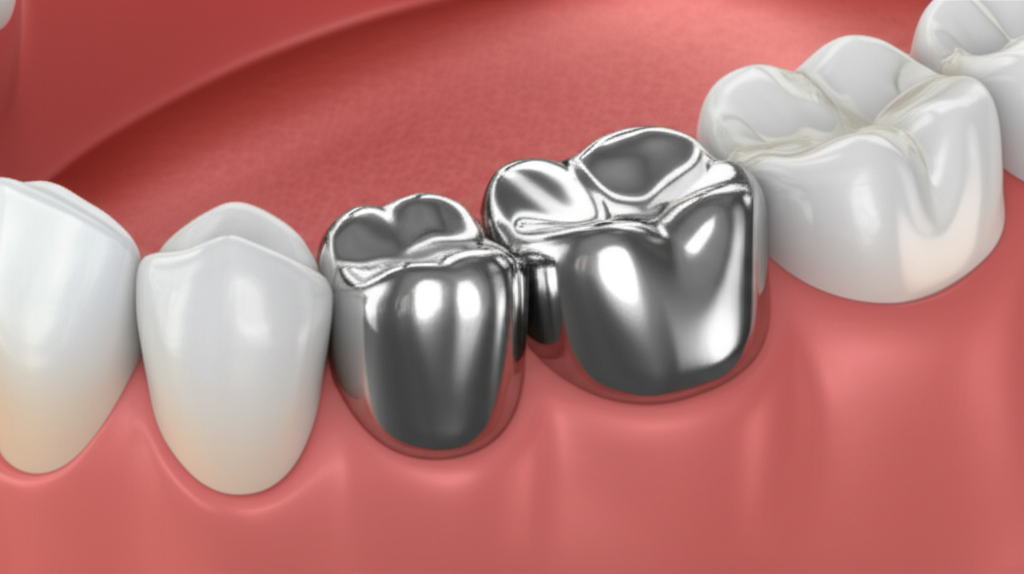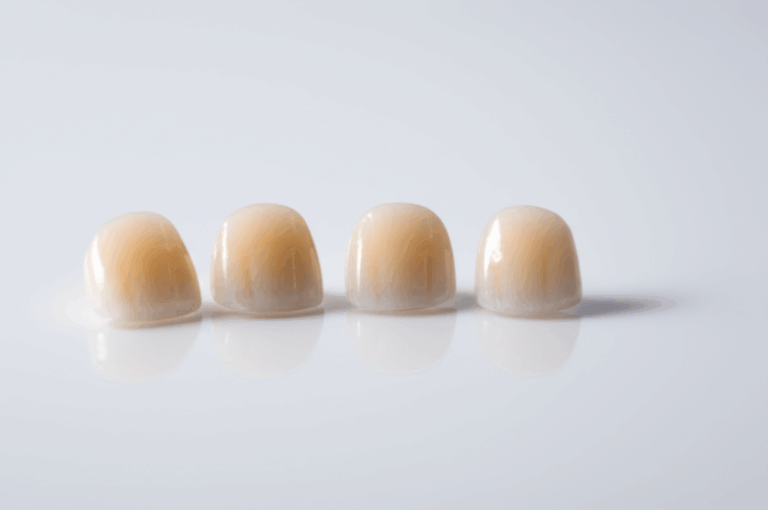
Why Do Dentists Use Silver Caps on Teeth? Understanding Amalgam, Stainless Steel, and Metal Crowns
Ever wondered why you sometimes see metallic caps on people’s teeth? Silver crowns and fillings have been used by dentists for a long time. This easy article explains what silver caps really are, why dentists use them, if they’re safe, and what newer options you have. By the end, you’ll know exactly what’s in your or your child’s mouth, and how to choose what’s best for your teeth.
Table of Contents
What Are Silver Caps on Teeth?
Let’s start simple. When you hear “silver cap,” you probably think of a shiny metal cover over a tooth. The words “silver cap” mean a few different things to dentists.
Dental Amalgam: The Old-Style Silver Filling
First, there’s dental amalgam. This is a silver-looking filling used in teeth for over 150 years. It’s made from about 50% mercury mixed with silver, tin, copper, and sometimes a bit of zinc. Dentists use it a lot to fix cavities in back teeth where you chew.
Stainless Steel Crowns: Used Most for Kids
Another kind of “silver cap” is the stainless steel crown (SSC). These are made ahead of time and fit over teeth, mostly for kids’ baby molars. Some adults get them too, just for a little while.
Full Metal and Porcelain-Fused-to-Metal Crowns
For grown-ups, sometimes you’ll get a full metal crown or a porcelain-fused-to-metal (PFM) crown. Full metal crowns are made from gold or other metals for strength. PFM crowns have a tooth-colored outside over a metal inside, for a more natural look that’s still strong.
So, “silver cap” can mean a silver-colored filling, a stainless steel crown, or a full metal crown, depending on what’s going on in your mouth.
Why Do Dentists Use Silver Caps?
Good question! Dentists don’t use silver caps just to make your tooth shiny. There’s a reason behind it.
1. Hard to Break and Super Strong
Think how your back teeth have to bite tough foods like crunchy apples or meats. Dental amalgam and metal crowns are built strong for these jobs. These metals don’t break or wear down as quickly as many white fillings. That’s why dentists still like using them, even if they’re not as pretty.
2. Cheaper Than Most Other Kinds
Dental work can cost a lot. Silver fillings and stainless steel crowns are usually less expensive than newer, whiter options. If you need to save money or need to treat your child’s teeth, silver caps are a good pick.
3. They’ve Worked for Years and Years
Dentists trust them because they used them for many years. Amalgam fillings and stainless steel crowns have been used for a long time and usually last well. They’re trusted by big organizations and dentists around the world.
4. Needed for Special Tooth Problems
Dentists sometimes pick silver caps if your tooth is too messed up for a normal filling, or a kid needs something strong and fast. For example, if a kid’s baby molar has had nerve work, placing a stainless steel crown keeps it safe until it falls out naturally.
Are Silver Caps Safe for You and Your Children?
The word “mercury” might sound scary. Let’s talk about the real facts.
Dental Amalgam and Mercury
Yes, amalgam has mercury, but it’s locked in with other metals to make it safe. All big health groups (like the FDA and WHO) agree it’s safe for almost everyone, except people who are allergic or have rare health issues. The little bit of mercury vapor you might breathe in while chewing or drinking something hot is so tiny it doesn’t cause harm for most folks.
The Minamata Convention asks dentists to use less amalgam to help nature, not because it’s dangerous to you.
How Safe Are Metal Crowns?
Stainless steel crowns and other metal crowns are usually safe too. Allergic reactions (like to nickel) don’t happen much, but your dentist will make sure you’re not allergic. If you are, another crown can be picked instead.
I’ve seen thousands of people with silver fillings or metal crowns. Nearly all of them do just fine with their dental work for lots of years!
What Are the Pros and Cons of Silver Caps?
Here are the good things and the not-so-good things about silver caps.
Pros of Silver Caps
- Very strong: Great for heavy chewing.
- Last a long time: Can last 15 years or even more.
- Lower cost: Less expensive than gold or tooth-colored crowns.
- Trustworthy: Less likely to get a cavity again at the edges.
Cons of Silver Caps
- Stand out: They look like metal in your mouth (not so nice on front teeth).
- Feel more heat and cold: Metal gets cold and hot fast, so you might get a quick ouch with ice cream or hot drinks.
- Allergies: Rare, but possible.
- Need more shaping: Some crowns need more of your natural tooth taken away.
If you want your teeth to look like teeth, talk to your dentist—there are better-looking options out there!
What Alternatives Exist to Silver Caps?
Don’t want metal in your smile? Here’s what you can try.
Composite Resin (White Fillings)
These fillings match your tooth color. Dentists glue them in, so they’re great for small fixes and front teeth.
Ceramic (Porcelain or Zirconia) Crowns
Ceramic crowns are great for adults who want both strong teeth and a natural look. Zirconia is almost as tough as metal but looks like a real tooth. You can learn more about zirconia crowns from a zirconia dental lab.
Gold Crowns
Gold crowns last a really long time and don’t cause allergies very much. Still, they are pricey and easy to see.
Glass Ionomer Fillings
Sometimes used for kids or spots that don’t bite down hard. They give off a little fluoride, which helps protect teeth, but they’re not that strong.
Everyone is different. Your dentist can work with a good dental ceramics lab to find the choice that fits your teeth and wallet.
When Is a Silver Cap the Right Choice?
Not sure if you need a silver cap? Here’s when dentists often pick them.
Big Cavities in Kids
Sometimes, a child’s baby tooth gets a cavity too big for a normal filling. Stainless steel crowns work fast, hold up well, and are not expensive.
Adults with Tough Biting or Grinding
If you have a super strong bite or grind your teeth, a full metal crown might be suggested. Also, if the tooth is all the way in the back and hidden, you might care more about strength than looks.
For a Short Time
Sometimes a metal crown is put on while a more natural, custom one is made. This protects your tooth until the final crown arrives.
Your dentist can help you decide. He or she will help you figure out what fits your needs, wallet, and smile.
How Long Do Silver Caps Last?
Silver caps are the superheroes of dental work—they last a long time!
Dental Amalgam
Most last 10 to 20 years, but some stay put for more than 30 years. How long it lasts depends on the filling’s size, where it is, and how you take care of your teeth.
Stainless Steel Crowns
For kids, these last until the baby tooth falls out, which could be 2 to 5 years or more. For adults, they are just for a few months or up to 2 years.
Metal Crowns
Gold or other metal crowns in adults can last 15 to 30 years—maybe even longer with good brushing and care.
Here’s a simple table:
| Type | Average Lifespan | Strength | Looks |
|---|---|---|---|
| Amalgam Filling | 10–20+ years | Very Strong | Silver/Grey |
| Stainless Steel | 2–5 years (kids) | Very Strong | Silver |
| Metal Crown | 15–30+ years | Super Strong | Silver or Gold |
| Ceramic/Zirconia | 10–15 years | Excellent | Looks Natural |
| Composites | 5–10 years | Good | Looks Natural |
What Happens During the Silver Cap Procedure?
Getting a silver cap sounds like a lot, but it’s usually not hard.
Step 1: Checking Out the Tooth
Your dentist looks at the tooth and maybe takes an X-ray. He or she will clean out any cavities and figure out what you need.
Step 2: Getting the Tooth Ready
For a metal crown, the tooth might need to be shaped so the cap fits right. Sometimes, a coming-soon filling is used.
Step 3: Putting on the Cap
- For amalgam, your dentist mixes up the silver material, presses it into the cavity, and it hardens fast. You’re done in one visit.
- For a crown, you might get a ready-made cap or a dentist takes a mold and sends it to a crown and bridge lab. You’ll get your final, fitted crown next visit.
Usually, you’ll be fine after.
How Do You Care for Silver Caps?
Want your new filling or crown to last? Here’s what to do.
- Brush two times a day with a toothpaste that has fluoride.
- Floss every day to keep away new cavities and gum troubles.
- Don’t chew ice or hard objects like pens or popcorn kernels.
- See your dentist every 6 months for cleanings and exams.
Caps or fillings last a long time if you look after them! If you feel pain, notice rough parts, or your cap feels loose, call your dentist.
The Future of Silver Caps and Dental Materials
Things are changing in the dental world. More people want fillings and crowns that blend in.
- Fewer people get amalgam fillings now, especially where people care how their teeth look.
- Ceramic and white fillings are more popular now, thanks to better tech and places like digital dental labs.
- But for some back teeth or tough jobs, metal still works best.
New metals and ceramics are getting better all the time, aiming to be both strong and look natural. Dental labs keep working on safer, longer-lasting choices!
Frequently Asked Questions About Silver Caps
Q: Do silver caps set off metal detectors?
A: No! They are too small to set off alarms at airports or stores.
Q: Can I be allergic to a silver cap?
A: It’s rare—but if you are allergic to nickel or other metals, let your dentist know.
Q: Do silver caps last forever?
A: They last a long time—sometimes 20+ years— but not forever. Keep up with visits.
Q: My child’s silver cap looks dark—is that normal?
A: Yes! Stainless steel crowns can look a bit darker as they age, but they still work fine.
Q: Will my insurance pay for a silver cap?
A: Most dental plans cover silver fillings and stainless steel crowns for kids, but check your plan.
Key Points to Remember
- Silver caps, silver fillings, and metal crowns are very strong, less expensive, and trusted for lots of years.
- They’re safe for most people, with only rare problems for those with allergies or special cases.
- If you want your teeth to look natural, ask about ceramic, white, or zirconia choices.
- Brushing, flossing, and regular checkups keep your dental work going strong.
- Your dentist and a trusted lab like a china dental lab or dental ceramics lab can help you get the best tooth fix for you.
If you’re still not sure which type of dental work is right for you or your child, ask your dentist! Your teeth are worth it.








